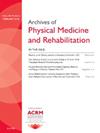促进中风后上肢的使用:商业健身追踪器和研究级加速度计的比较
IF 3.6
2区 医学
Q1 REHABILITATION
Archives of physical medicine and rehabilitation
Pub Date : 2025-04-01
DOI:10.1016/j.apmr.2025.01.081
引用次数: 0
摘要
目的比较商业健身追踪器与“金标准”科研级加速度计在准确量化上肢运动方面的差异。评估商业健身追踪器在临床环境和自然、非受控环境中的可行性。在这项观察性研究中,参与者被招募进行了2小时的初次访问,随后是3天的家庭监测期,以及简短的随访和离职面谈。参与者被要求在前臂的套筒中佩戴3个传感器(ActiGraph、Fitbit和Apple Watch)。在初次访问期间,参与者在实验室环境中进行日常生活活动(如穿衣、打字、走路)。实验环境实验室和家庭环境都是研究环境。参与者本研究招募了30名健康参与者和10名中风参与者。中风参与者被要求是右脑受影响,右手占优势,并且居住在社区,以便纳入研究。健康参与者要求年龄≥50岁,并且居住在社区。本研究的干预措施是使用商业健身追踪器和研究级加速度计来测量上肢运动。在家庭监测期间,除睡觉和洗澡外,传感器在袖子中佩戴3天。主要结果测量苹果和Fitbit使用的主要结果测量是步数和活动分钟。步数评估加速方向的变化,或上下移动的UE。运动分钟是一项运动持续时间和强度的综合测量。ActiGraph的结果测量是时间(活动计数持续时间)和幅度(强度)。来自ActiGraph的数据通过ActiLife进行预处理,并通过基于验证方法的定制编写的MATLAB程序进行进一步分析。结果初步分析表明,商用传感器的灵敏度随活动的不同而不同。在精细运动活动中(例如使用iPad),尽管ActiGraph显示持续的小运动,但Fitbit和Apple Watch显示的变化有限。在其他粗大的活动(如叠毛巾)中,Fitbit和Apple Watch估计了ActiGraph捕捉到的60%-70%的手部动作。结论将使用相关性和回归进一步分析,以证明商业级和研究级传感器在卒中中的关系。我们希望建立算法来转换商业数据,直接显示日常的手部使用情况。结果可能为临床应用提供了一种替代方法,使临床医生和患者能够利用低成本、广泛使用的商业传感器来了解和促进日常生活中的手部使用。本文章由计算机程序翻译,如有差异,请以英文原文为准。
Promotion of Poststroke Upper Extremity Usage: A Comparison of Commercial Fitness Trackers and a Research-grade Accelerometer
Objectives
To compare commercial fitness trackers and the “gold standard” research-grade accelerometer in regards to accurately quantifying upper extremity movements. To assess the feasibility of commercial fitness trackers in both clinical settings and natural, uncontrolled environments.
Design
In this observational study, participants were recruited to engage in a 2-hour initial visit, followed by a 3-day home monitoring period, and brief follow-up visit with an exit interview. Participants were asked to wear 3 sensors (ActiGraph, Fitbit, and Apple Watch) in a sleeve on both forearms. During the initial visit, participants performed activities of daily living (eg, dressing, typing, walking) in a laboratory environment.
Setting
Both laboratory and home environments were study settings.
Participants
Thirty healthy participants and 10 stroke participants were recruited for this study. Stroke participants were required to be right-side affected, right-hand dominant, and community-dwelling in order to be included in the study. Healthy participants were required to be ≥50 years and also community-dwelling.
Interventions
The intervention in this study was use of commercial fitness trackers and a research-grade accelerometer to measure upper extremity movements. For the home monitoring period, sensors are worn in sleeves for 3 days, with the exception of sleeping and showering.
Main Outcome Measures
The main outcome measures used for Apple and Fitbit were step counts and active minutes. Step count assesses the changes in acceleration direction, or up and down movements of the UE. Active minutes is a combined measurement of the duration and intensity of an activity. The outcome measures for ActiGraph are time (duration in activity counts) and magnitude (intensity). Data from ActiGraph is preprocessed through ActiLife and further analyzed via a custom-written MATLAB program based on validated methods.
Results
Preliminary analysis showed that the sensitivity of the commercial sensors varies across activities. During the fine motor activities (eg, using iPad), although ActiGraph indicated consistent small movements, Fitbit and Apple Watch showed limited changes. In other gross activities (eg, folding towels), Fitbit and Apple Watch estimated 60%-70% of the hand-use movements captured in ActiGraph.
Conclusions
Further analysis using correlations and regressions will be conducted to demonstrate the relationship between commercial and research-grade sensors in stroke. We expect to establish algorithms to transform commercial data to directly indicate daily hand use. The results may suggest an alternative for clinical use to allow clinicians and patients to utilize low-cost, widely used commercial sensors to understand and promote hand use in daily life.
Disclosures
none.
求助全文
通过发布文献求助,成功后即可免费获取论文全文。
去求助
来源期刊
CiteScore
6.20
自引率
4.70%
发文量
495
审稿时长
38 days
期刊介绍:
The Archives of Physical Medicine and Rehabilitation publishes original, peer-reviewed research and clinical reports on important trends and developments in physical medicine and rehabilitation and related fields. This international journal brings researchers and clinicians authoritative information on the therapeutic utilization of physical, behavioral and pharmaceutical agents in providing comprehensive care for individuals with chronic illness and disabilities.
Archives began publication in 1920, publishes monthly, and is the official journal of the American Congress of Rehabilitation Medicine. Its papers are cited more often than any other rehabilitation journal.

 求助内容:
求助内容: 应助结果提醒方式:
应助结果提醒方式:


